Journal of the NACAA
ISSN 2158-9429
Volume 4, Issue 2 - November, 2011
Managing Glyphosate-Resistant Palmer Amaranth in Conservation Tillage Cotton
- Kichler, J.M., Macon County Extension Coordinator, University of Georgia Cooperative Extension
Culpepper, A.S., Extension Weed Specialist, University of Georgia, Department of Crop and Soil Sciences
ABSTRACT
Glyphosate-resistant Palmer amaranth (Amaranthus palmeri) threatens the production of conservation tillage cotton in Macon County, Georgia. In 2004 when glyphosate-resistant Palmer amaranth was initially confirmed in Macon County (Culpepper et al, 2006), growers implemented conservation tillage production practices to produce 60% of the cotton in the county (Kichler et al, 2009). By 2008, conservation tillage production was reduced to 10% of the acreage as this resistant pest forced growers to produce cotton using tillage. An experiment was conducted to determine the impact of cover crop biomass and herbicide programs on the control of glyphosate-resistant Palmer amaranth in dryland conservation tillage production.
Introduction
Glyphosate-resistant Palmer amaranth (Amaranthus palmeri) threatens the production of conservation tillage cotton in Macon County, Georgia. In 2004 when glyphosate-resistant Palmer amaranth was initially confirmed in Macon County (Culpepper et al, 2006), growers implemented conservation tillage production practices to produce 60% of the cotton in the county (Kichler et al, 2009). By 2008, conservation tillage production was reduced to 10% of the acreage as this resistant pest forced growers to produce cotton using tillage. An experiment was conducted to determine the impact of cover crop biomass and herbicide programs on the control of glyphosate-resistant Palmer amaranth in dryland conservation tillage production.
Materials and Methods
The experiment was conducted in Macon County, Georgia during 2008 in a field with a heavy population of glyphosate-resistant Palmer amaranth. The experimental design was a randomized complete block replicated four times. A factorial arrangement of treatments including four cover crops (oat, rye, wheat, and no cover), two cover crop termination dates (4 or 2 weeks before planting[WBP]), and three herbicide program options including no herbicides or Prowl H20 (pendimethalin)1 at 2 pt/a plus Reflex (fomesafen)2at 1 pt/a preemergence (PRE) followed by either Roundup WeatherMax (glyphosate)3at 22 oz/a plus Dual Magnum (S-metolachlor)4at 1 pt/a or Ignite 280 (gluphosinate)5 at 23 oz/a plus Dual Magnum at 1pt/a applied topically to 5-leaf cotton and Direx (diuron)6at 1 qt/a plus MSMA (monosodium acid methanearsonate)7at 2.5 pt/a directed to 13-leaf cotton. The table 1 below shows the herbicide programs.
Table 1. Herbicide Treatments and Timing for Glyphosate Resistant Palmer amaranth control with different cover crop treatments, Macon County, GA 2008
|
Treatment |
Herbicide Timings |
||
|
Pre-emerge |
Post-Emerge (5 Leaf Cotton ) |
Layby (13 Leaf Cotton) |
|
|
1 |
|
|
|
|
2 |
Prowl H20 (2 pt/A) + Reflex (1 pt/A) |
Roundup WeatherMax (22 oz/A) + Dual Magnum (1 pt/A) |
Direx (1 qt/A) plus MSMA (2.5 pt/A) |
|
3 |
Prowl H20 (2 pt/A) + Reflex (1 pt/A) |
Ignite 280 (23 oz/A) + Dual Magnum (1 pt/A) |
Direx (1 qt/A) plus MSMA (2.5 pt/A) |
The no cover system was disked twice followed by ripping and bedding prior to planting. In all cover crop systems, a 2008 KMC strip-tillage implement with ripper shanks and rolling baskets was used to prepare the seedbed. Plot size was 4 rows by 30 feet and the first rainfall occurred 5 days after planting Phytogen 485 Widestrike Roundup Ready Flex cotton and applying PRE herbicides. Cover crop biomass at planting, Palmer amaranth control throughout the season, visual cotton injury, and cotton yield were measured. Percent Palmer amaranth control and visual cotton injury was evualuated by visually comparing the treated plots to the untreated check in each replication. Data were subjected to analysis of variance using the PROC MIXED procedure of SAS (ver. 9.2; SAS Institute; Cary, NC). Means were separated using Fishers Protected LSD test at the 0.05 significance level.
Results
Figure 1, shows biomass accumulation of the three cover crops influenced by the two termination dates at planting. Cover crop plant biomass for rye, wheat, and oat was 5200, 2900, and 3000 lb/A, respectively, when the cover crops were killed 4 weeks before planting (WBP). When the cover crops were terminated at 2 WBP the biomass production significantly increased.
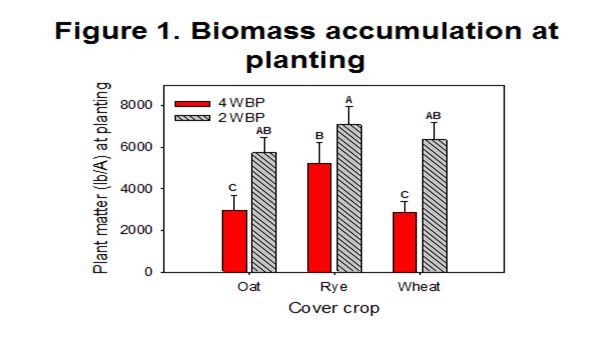
Figure 2 shows Palmer amaranth control at 4 weeks after planting (WAP) comparing the cover crop treatments, herbicide programs and the two cover crop termination dates. Systems including higher levels of residue improved Palmer amaranth control by 7 to 27% when averaged over the herbicide program at 4 WAP.
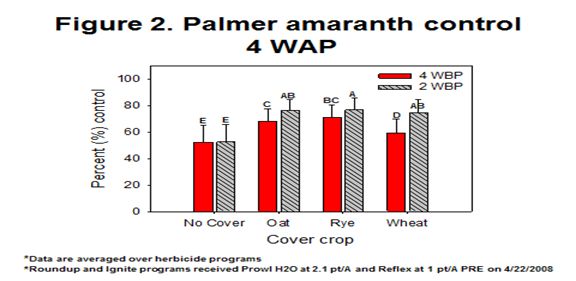
Figure 3, shows Palmer amaranth control at 4 WAP comparing the 4 cover crop treatments and the 3 herbicide treatments. The cover crops alone provided less than 40% control. Prowl plus Reflex applied PRE provided excellent early-season control with only a few plants escaping by 4 WAP. Postemergence applications were applied when Palmer amaranth was three inches or less. Roundup plus Dual Magnum did not control emerged Palmer amaranth plants while Ignite plus Dual Magnum provided nearly complete control.
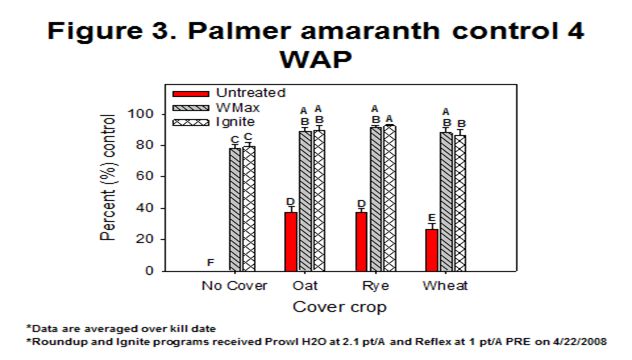
Figure 4 below shows Palmer amaranth control at layby. Layby is defined as a herbicide application that is directed at the base of the cotton plant just before canopy closure. At layby, any plant escaping topical herbicide applications was too large to control. The Ignite program provided 93% control at harvest; this level of control was 43% greater than that noted with the Roundup program, when averaged over crop crops and cover crop termination dates. The cover crops alone provided less than 40% control.
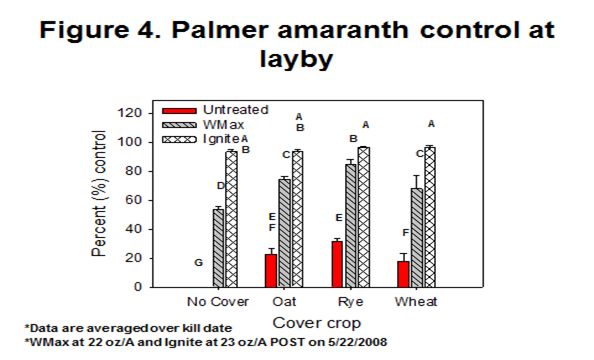
Visual herbicide injury was not noted with Prowl plus Reflex applied at planting or with directed applications of Direx plus MSMA. At 5 day after treatment, Roundup plus Dual Magnum injured cotton 15% while Ignite plus Dual Magnum injured cotton 30% including occasional leaf drop. By 15 day after treatment, injury was less than 5% with all treatments.
Figure 5 shows the seed cotton yields at harvest. Seed cotton yield was influenced only by herbicide program. Cotton could not be harvested when herbicides were not applied. Seed cotton yield (1291 lb/A) with the Roundup program was 38% less than seed cotton yield (2093lb/A) with the Ignite program.
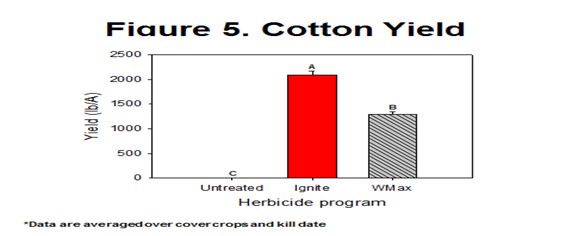
Sources of Materials
1Prowl® H2O, pendimethalin, BASF Ag Products, P.O. Box 13528, 26 Davis Drive, Research Triangle Park, NC 27709-3528.
2 Reflex®, fomesafen, Syngenta Crop Protection, Inc., P.O. Box 18300, Greensboro, NC 27419.
3Roundup WeatherMax®, glyphosate, Monsanto Company, 800 North Lindbergh Blvd., St. Louis, MO 63167.
4Dual Magnum®, s-metolachlor, Syngenta Crop Protection, Inc., P.O. Box 18300, Greensboro, NC 27419.
5 Ignite®, gluphosinate, Bayer CropScience, P.O. Box 12014, Research Triangle Park RTP, North Carolina 27709.
6 Direx®, diuron, Dupont Crop Protection, Laurel Run Building, Chestnut Run Plaza Wilmington, DE 19898.
7 MSMA, monosodium acid methanearsonate, Drexel Chemical Company, 1700 Channel Avenue Memphis, TN 38113.
References
Culpepper, A.S., Grey, T.L., Vencill, W.K., Kichler, J.M., Webster, T.M., Brown, S.M., Davis, J.W., and Hanna, W.W. (2006). “Glyphosate-resistant Palmer Amaranth (Amaranthus palmeri) confirmed in Georgia.” Weed Science, vol 54, pg. 620-626.
Kichler, J.M., Culpepper, A.S., York, A.C., and Sosnoski, 2010. L.M. Managing glyphosate resistant Palmer amaranth in conservation tillage cotton. Proceedings of the 2010 Beltwide Cotton Conference, San Antonio, TX, Abstract.
